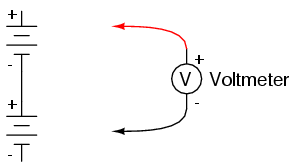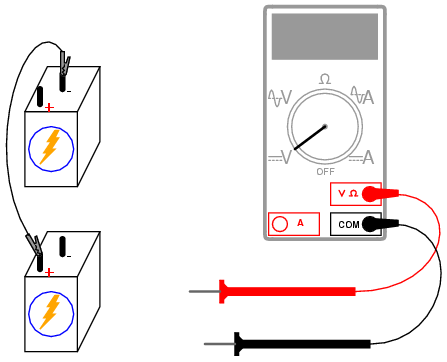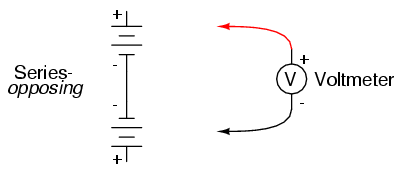Series batteries
PARTS AND MATERIALS
-
Two 6-volt batteries
-
One 9-volt battery
Actually, any size batteries will suffice
for this experiment, but it is recommended to have at least
two different voltages available to make it more
interesting.
CROSS-REFERENCES
Lessons In Electric Circuits, Volume
1, chapter 5: "Series and Parallel Circuits"
Lessons In Electric Circuits, Volume
1, chapter 11: "Batteries and Power Systems"
LEARNING OBJECTIVES
SCHEMATIC DIAGRAM

ILLUSTRATION

INSTRUCTIONS
Connecting components in series means
to connect them in-line with each other, so that there is
but a single path for electrons to flow through them all. If
you connect batteries so that the positive of one connects
to the negative of the other, you will find that their
respective voltages add. Measure the voltage across each
battery individually as they are connected, then measure the
total voltage across them both, like this:

Try connecting batteries of different sizes
in series with each other, for instance a 6-volt battery
with a 9-volt battery. What is the total voltage in this
case? Try reversing the terminal connections of just one of
these batteries, so that they are opposing each other like
this:

How does the total voltage compare in this
situation to the previous one with both batteries "aiding?"
Note the polarity of the total voltage as indicated by the
voltmeter indication and test probe orientation. Remember,
if the meter's digital indication is a positive number, the
red probe is positive (+) and the black probe negative (-);
if the indication is a negative number, the polarity is
"backward" (red=negative, black=positive). Analog meters
simply will not read properly if reverse-connected, because
the needle tries to move the wrong direction (left instead
of right). Can you predict what the overall voltage polarity
will be, knowing the polarities of the individual batteries
and their respective strengths?
|